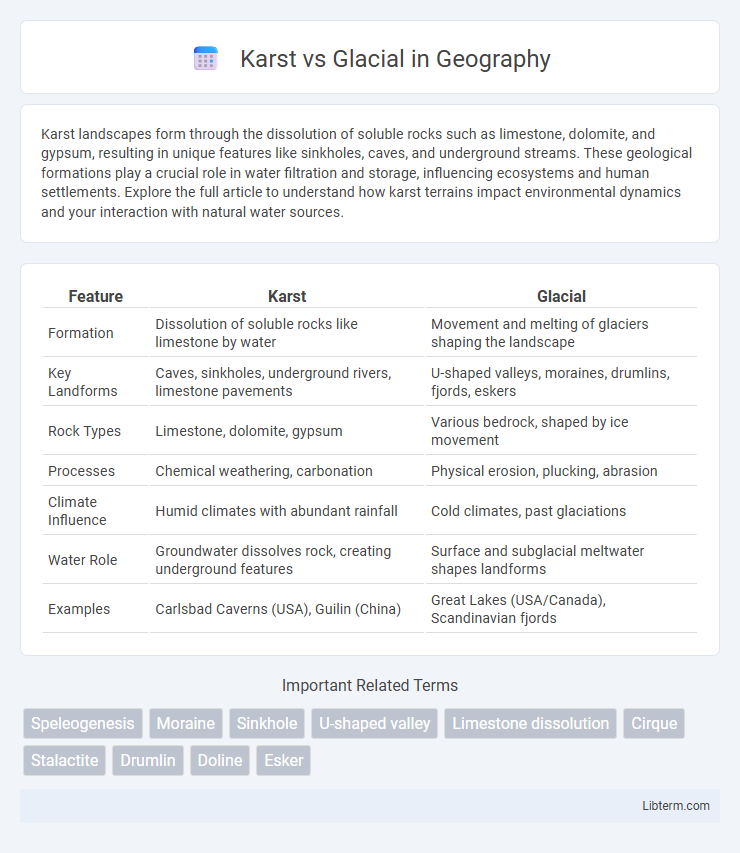Karst landscapes form through the dissolution of soluble rocks such as limestone, dolomite, and gypsum, resulting in unique features like sinkholes, caves, and underground streams. These geological formations play a crucial role in water filtration and storage, influencing ecosystems and human settlements. Explore the full article to understand how karst terrains impact environmental dynamics and your interaction with natural water sources.
Table of Comparison
| Feature | Karst | Glacial |
|---|---|---|
| Formation | Dissolution of soluble rocks like limestone by water | Movement and melting of glaciers shaping the landscape |
| Key Landforms | Caves, sinkholes, underground rivers, limestone pavements | U-shaped valleys, moraines, drumlins, fjords, eskers |
| Rock Types | Limestone, dolomite, gypsum | Various bedrock, shaped by ice movement |
| Processes | Chemical weathering, carbonation | Physical erosion, plucking, abrasion |
| Climate Influence | Humid climates with abundant rainfall | Cold climates, past glaciations |
| Water Role | Groundwater dissolves rock, creating underground features | Surface and subglacial meltwater shapes landforms |
| Examples | Carlsbad Caverns (USA), Guilin (China) | Great Lakes (USA/Canada), Scandinavian fjords |
Introduction to Karst and Glacial Landscapes
Karst landscapes form through the dissolution of soluble rocks such as limestone, dolomite, and gypsum, creating distinctive features like sinkholes, caves, and underground drainage systems. Glacial landscapes result from the movement and melting of glaciers, carving out valleys, fjords, and moraines, shaped by ice erosion and deposition. Both landforms exemplify unique geological processes driven by water--chemical weathering in karst terrains and physical sculpting in glacial regions.
Formation Processes: Karst vs Glacial
Karst landscapes form through the chemical weathering and dissolution of soluble rocks like limestone, resulting in features such as sinkholes, caves, and underground drainage systems. Glacial landscapes develop via the mechanical erosion and deposition caused by moving ice masses, creating landforms like U-shaped valleys, moraines, and drumlins. These formation processes highlight the contrast between chemical dissolution in karst terrains and physical sculpting by ice in glacial environments.
Key Geological Features of Karst Terrains
Karst terrains are characterized by distinctive geological features such as sinkholes, underground caves, and extensive limestone pavements formed by the dissolution of soluble rocks like limestone and dolomite. These landscapes exhibit unique drainage patterns with disappearing streams and complex subterranean river systems, contrasting sharply with glacial terrains shaped primarily by ice movement, moraines, and U-shaped valleys. The presence of speleothems like stalactites and stalagmites further differentiates karst regions through ongoing chemical weathering and mineral deposition processes.
Distinctive Landforms in Glacial Regions
Glacial regions are characterized by distinctive landforms such as U-shaped valleys, fjords, and moraines formed through the processes of glacial erosion and deposition. Cirques and aretes are common features resulting from the intense glacial carving of mountainous terrain. These landforms contrast sharply with karst landscapes, which are shaped primarily by the dissolution of soluble rocks like limestone, leading to sinkholes, caves, and underground drainage systems.
Water Movement and Drainage Patterns
Karst landscapes feature irregular water movement through soluble rock formations, such as limestone, creating underground drainage systems with sinkholes, caves, and disappearing streams. In contrast, glacial terrains display surface-dominated drainage, where meltwater flows over impermeable, often compacted glacial deposits, forming braided rivers and proglacial lakes. The distinctive water movement in karst leads to rapid infiltration and subterranean drainage, while glacial areas emphasize surface runoff and slower subsurface flow due to limited permeability.
Biodiversity and Ecosystems in Karst vs Glacial Areas
Karst landscapes harbor unique biodiversity due to their complex underground cave systems and nutrient-poor soils, supporting specialized flora and fauna adapted to acidic and calcium-rich environments. Glacial areas, characterized by nutrient-rich sediments and dynamic meltwater ecosystems, sustain a range of cold-adapted species and seasonal habitats essential for migratory birds and aquatic life. Differences in soil composition, hydrology, and microclimates drive distinct ecosystem structures, making Karst and Glacial zones critical for conserving diverse biological communities.
Human Interaction and Usages
Karst landscapes, characterized by limestone caves and sinkholes, have been utilized by humans for water storage, agriculture, and tourism, with many ancient civilizations developing settlements around natural springs and underground rivers. Glacial regions, shaped by past ice movements, offer resources such as freshwater from melting glaciers and fertile soils deposited by retreating ice, supporting agriculture and hydroelectric power generation. Both landforms influence human activities, with karst terrains posing challenges like groundwater contamination, while glacial areas impact infrastructure due to seasonal melt and shifting landscapes.
Environmental Threats and Conservation
Karst landscapes face environmental threats such as groundwater contamination, habitat loss, and over-extraction of water due to their porous limestone formations that support unique ecosystems. Glacial environments are threatened by climate change-induced melting, resulting in habitat degradation, sea-level rise, and loss of freshwater reserves. Conservation efforts in karst areas emphasize protecting aquifers and fragile biodiversity, while glacial conservation prioritizes climate mitigation and preserving glacial meltwater-dependent habitats.
Notable Examples Around the World
Notable karst landscapes include the Guilin Karst in China, famed for its distinctive limestone towers, and the Mammoth Cave system in the USA, the world's longest cave network. Iconic glacial examples include the Fjords of Norway, shaped by glacial erosion, and the Patagonian Ice Fields in South America, significant for their extensive glacier coverage. These formations highlight the impact of karst processes on limestone dissolution versus the sculpting force of glaciers on mountainous terrain.
Summary: Comparing Karst and Glacial Landscapes
Karst landscapes are characterized by features such as sinkholes, caves, and underground drainage formed primarily by the dissolution of soluble rocks like limestone. Glacial landscapes display distinct landforms including U-shaped valleys, moraines, and drumlins, resulting from the movement and melting of glaciers. The key difference lies in the processes shaping them: karst results from chemical weathering and erosion, while glacial landscapes are sculpted by physical forces of ice movement.
Karst Infographic

 libterm.com
libterm.com